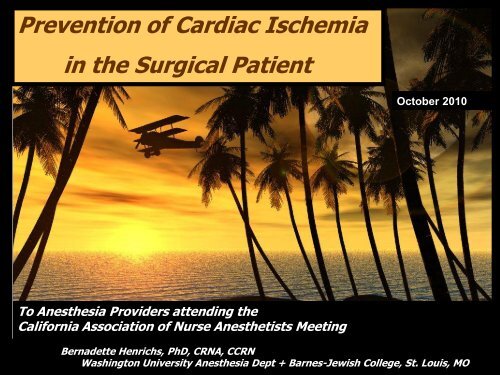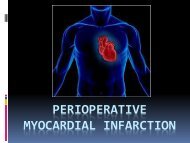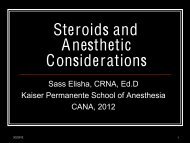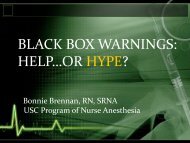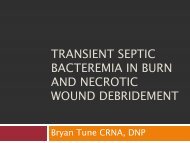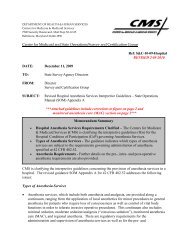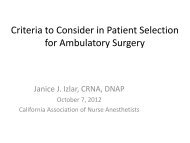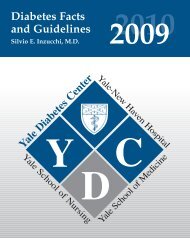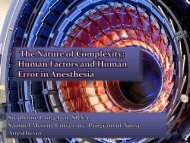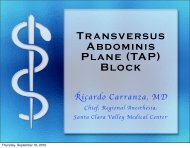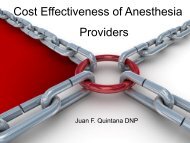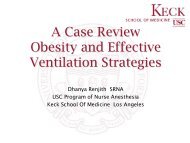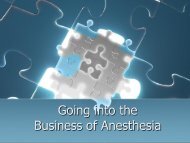Prevention Of Cardiac Ischemia In The Surgical Patient - California ...
Prevention Of Cardiac Ischemia In The Surgical Patient - California ...
Prevention Of Cardiac Ischemia In The Surgical Patient - California ...
You also want an ePaper? Increase the reach of your titles
YUMPU automatically turns print PDFs into web optimized ePapers that Google loves.
<strong>Prevention</strong> of <strong>Cardiac</strong> <strong>Ischemia</strong><br />
in the <strong>Surgical</strong> <strong>Patient</strong><br />
October 2010<br />
To Anesthesia Providers attending the<br />
<strong>California</strong> Association of Nurse Anesthetists Meeting<br />
Bernadette Henrichs, PhD, CRNA, CCRN<br />
Washington University Anesthesia Dept + Barnes-Jewish College, St. Louis, MO
Objectives<br />
• Describe the significance of heart disease in the<br />
surgical patient.<br />
• List risk factors for heart disease.<br />
• Discuss the importance of preventing ischemia in the<br />
surgical patient.<br />
• Describe the importance of controlling<br />
hemodynamics.<br />
• Explain the role of beta blockers in the surgical patient<br />
at risk for perioperative cardiac ischemia.<br />
• Give an example of a case where a beta blocker may<br />
be beneficial.
Case Study<br />
• 85-year-old, 50-kg female with a history of nausea<br />
and vomiting for 24 hours now presents with an acute<br />
abdomen. Hx of HTN, PVD, COPD, inferior MI one<br />
month ago<br />
• <strong>In</strong>duction with 100 mcg fentanyl, 50 mg propofol and<br />
50 mg succinylcholine<br />
• After induction, patient’s B/P decreased from 120/85<br />
to 60/38; Heart rate increased from 72 to 130’s.
Heart Disease<br />
• Sedentary people are almost twice as likely to suffer heart<br />
attacks than people who exercise regularly.<br />
<br />
Men suffer heart attacks ~10 years earlier than women do.<br />
• Women tend to be older and sicker when they are treated<br />
for a heart attack and have less common symptoms.<br />
• <strong>In</strong> 2010, heart disease will cost the U.S. over $300 billion<br />
(<strong>In</strong>cludes HC services, medications, and lost productivity)<br />
Center for Disease Control & <strong>Prevention</strong> 8-2010
Heart Disease & Smoking<br />
• Smokers have twice the risk of developing heart disease as<br />
nonsmokers.<br />
• Smokers who have a heart attack are more likely to die within<br />
an hour of the heart attack than nonsmokers.<br />
• <strong>In</strong>creases heart muscle oxygen demand by 10%.<br />
• Reduces coronary artery blood flow due to adrenaline release<br />
and reduces ability to dilate the arteries<br />
• After five years of giving up smoking, the risk of developing<br />
heart disease is the same as for someone who never smoked.<br />
http://www.mamashealth.com/Heart_stat.asp; heart disease statistics 8-2010
Heart Disease and Surgery<br />
• 400,000 per year will have cardiac surgery<br />
<br />
25% will have perioperative CV morbidity<br />
• 30 million will have noncardiac surgery<br />
<br />
5% (1.5 million) will have perioperative CV morbidity<br />
with half of these people suffering an MI<br />
<br />
More than half of the deaths after surgery will be<br />
caused by cardiac events
Heart Disease and Surgery<br />
• <strong>Of</strong> those at risk for perioperative complications,<br />
ischemia occurs in 20-40%<br />
• Pts with episodes of ischemia are more likely to die<br />
within the next 2 years<br />
• Associated with a 9-fold increase in risk of cardiac<br />
death, MI, or unstable angina<br />
• <strong>Patient</strong> may be asymptomatic until 70% or more<br />
occlusion occurs
Heart Disease and Surgery<br />
• More frequent and severe during<br />
the postoperative period<br />
• Postop MI is almost 3 X’s as<br />
frequent in patients with ischemia<br />
and is independent of when<br />
ischemia occurs<br />
• <strong>Ischemia</strong> is related significantly to<br />
perioperative tachycardia<br />
(Wallace)
Anesthesia and <strong>Ischemia</strong>
Detecting <strong>Ischemia</strong><br />
• Lead II:<br />
• P wave identification<br />
• Ventricular arrhythmias<br />
• Precordial leads: <strong>Ischemia</strong><br />
• V5:<br />
• Most useful to detect ST changes/ischemia of LV
Sensitivity to Detect <strong>Ischemia</strong><br />
• V 4 : 61%<br />
• V 5 : 75%<br />
• V 4 & V 5 : 90%<br />
• V 5 , Lead II: 95%<br />
• V 2 , V 3 , V 4 , V 5 , Lead II: 100%
ECG Changes:Pertinent information<br />
• ECG changes are a late finding in<br />
myocardial ischemia<br />
• Must be aggressively managed<br />
• Postoperatively, greatest incidence of<br />
ischemia occurs during first 48 hours
How healthy is the patient?<br />
Good LV Function<br />
• EF > 55%<br />
• LVEDP (wedge) < 12mmHg<br />
• CI > 2.5 L/min<br />
• No Angina<br />
• No CHF
Functional Capacity<br />
Most likely the best indicator of cardiac risk<br />
• Measured by history or formal exercise testing<br />
• Defined by metabolic equivalents (METs)<br />
• Relates activities to rates of metabolism<br />
• 1-4 METS:<br />
• Can eat, dress, walk around house, do dishes<br />
• 4-10 METS:<br />
• Can walk on level ground, run a short distance, climb 1 flight of<br />
stairs, golf<br />
• >10 METS:<br />
• Can swim, play tennis or football<br />
14
Impaired LV Function<br />
• EF < 40%<br />
• LVEDP > 18 mmHg<br />
• CI < 2.0 L/min<br />
• Essential HTN<br />
• CHF<br />
• Triad of Symptoms<br />
• Angina, syncope, dyspnea
Those at Risk for Perioperative <strong>Ischemia</strong><br />
• Age > 40 years<br />
• Obesity<br />
• HTN<br />
• Hypercholesterolemia<br />
• Dysrhythmias<br />
• Smoking history<br />
• PVD<br />
• Diabetes<br />
• Previous MI or angina/Family history
Perioperative Myocardial <strong>Ischemia</strong><br />
• If severe or prolonged, may result in:<br />
• Reversible damage (Stunned myocardium)<br />
• Irreversible damage (MI, sudden cardiac death)<br />
• Ventricular arrhythmias<br />
• Cardiogenic shock, CHF, pulmonary edema<br />
• Even if nonfatal, a poor outcome may occur
Types of MIs<br />
• Two types of heart attacks (First criterion):<br />
• Anterior infarct.<br />
• Most dangerous type of MI<br />
• Caused by a blockage in the branch of the LCA<br />
• Affects LV which pumps blood to all parts of the body and<br />
damages the front part of the heart.<br />
• Posterior or inferior infarct<br />
• Less serious<br />
• Caused by a blockage in the RCA or one of its branches<br />
• Affects the back or the base of the heart.<br />
18
Types of MIs<br />
• According to the second criterion<br />
• ST segment elevation MI (STEMI).<br />
• Caused by prolonged period of blocked blood supply<br />
• Affects a large portion of the myocardium<br />
• Causes significant changes on EKG & in blood chemical markers<br />
• Non-ST segment elevation MI (NSTEMI)<br />
• Caused by a partial or temporary blockage in blood supply<br />
• Extent of damage is minimal<br />
• No changes on EKG but blood markers indicate MI<br />
19
Types of MIs<br />
• According to the third criterion:<br />
• Transmural myocardial infarction<br />
• Results in death of three layers of tissue<br />
(epicardium, myocardium, and endocardium) of<br />
the myocardial wall.<br />
• Nontransmural myocardial infarction<br />
• Results in death of limited area of myocardial wall<br />
tissue.<br />
20
Anesthetic Goal<br />
Reduce the incidence and<br />
severity of perioperative<br />
myocardial ischemia and<br />
subsequent myocardial death.
Times of Stress & Catecholamine Release<br />
• Preoperative anxiety<br />
• <strong>In</strong>duction<br />
• <strong>In</strong>tubation<br />
• <strong>In</strong>cision<br />
• <strong>Surgical</strong> manipulation<br />
• Emergence<br />
• Extubation<br />
• Postoperative Awakening<br />
• Postoperative Pain
Anesthetic Choice<br />
• Each type of (General, regional, MAC) has<br />
implications regarding anesthetic and intraoperative<br />
monitoring<br />
• It can be beneficial to use volatile agents during<br />
noncardiac surgery in hemodynamically stable<br />
patients at risk for myocardial ischemia<br />
ACC/AHA 2007 Guidelines on perioperative CV Evaluation and care for noncardiac surgery.
Anesthetic Choice<br />
• If Regional anesthesia, high dermatomal levels may be<br />
associated with significant hemodynamic changes,<br />
including hypotension<br />
• MAC with insufficient local anesthetic by surgeon can<br />
lead to increased incidence of myocardial ischemia.<br />
• <strong>The</strong> anesthesia provider must select the best approach<br />
for the patient and type of surgery and hypoxemia and<br />
hypotension should be avoided<br />
ACC/AHA 2007 Guidelines on perioperative CV Evaluation and care for noncardiac surgery.
Importance of <strong>Prevention</strong><br />
A single episode of<br />
postoperative myocardial ischemia<br />
is associated with a ninefold increase<br />
in the incidence<br />
of cardiac complications<br />
before hospital discharge and<br />
a twofold increase<br />
during the next two years.<br />
Mangano DTl: NEJM 1990; 323: 1781-8, Mangano DTl: JAMA 1992; 268: 233-9
What can<br />
we do<br />
to prevent<br />
myocardial ischemia<br />
in<br />
surgical patients?
Balance Supply & Demand<br />
• <strong>In</strong>crease the supply of oxygen<br />
• Treat anemia<br />
• <strong>In</strong>crease FIO 2<br />
• Decrease the demand of oxygen<br />
• Decrease HR<br />
• Decrease contractility<br />
• Decrease preload and/or afterload<br />
• Prevent sympathetic stimulation
To Prevent <strong>Ischemia</strong><br />
• Suppress the sympathetic stimulation<br />
• Narcotics with induction<br />
• Deep anesthesia<br />
• Pharmacologic agents<br />
• Alpha 2 Adrenergic Agonists<br />
• Nitrates<br />
• Calcium channel blockers<br />
• Beta 1 blockers
Alpha 2 Adrenergic Agonists<br />
• Clonidine, dexmedetomidine<br />
• Prevent tachycardia, provide perioperative control of<br />
HTN<br />
• AHA/ACC 2007 Recommendations:<br />
• Alpha 2 agonists may be considered for pts with known<br />
CAD or at least one clinical risk factor undergoing<br />
surgery<br />
ACC/AHA 2007 Guidelines on perioperative CV Evaluation and care for noncardiac surgery.
Nitroglycerin<br />
• Reduces myocardial oxygen demand by decreasing preload ;<br />
<strong>In</strong>creases coronary perfusion by dilating coronary arteries and<br />
collateral circulation.<br />
• <strong>In</strong>traoperative NTG as prevention of ischemia and cardiac<br />
morbidity is unclear for high-risk pts having noncardiac surgery,<br />
especially those taking NTG for angina.<br />
• <strong>The</strong> recommendation for prophylactic use of NTG must consider<br />
the anesthetic plan and pt hemodynamics and must recognize<br />
that vasodilation and hypovolemia can readily occur during<br />
anesthesia and surgery.<br />
ACC/AHA 2007 Guidelines on perioperative CV Evaluation and care for noncardiac surgery.
Calcium Channel Blockers<br />
• Arterial vasodilation and negative inotropic effects<br />
• Meta-analysis in 2003 on perioperative use showed<br />
significantly reduced ischemia & SVT along with<br />
decreased MI and death<br />
• Post-hoc analysis demonstrated significantly reduced MI<br />
and/or death<br />
• More research needed<br />
ACC/AHA 2007 Guidelines on perioperative CV Evaluation and care for noncardiac surgery.
Beta Blockers<br />
• Protect against ischemia and myocardial reinfarction<br />
• Reduce the incidence of postoperative ischemic<br />
events<br />
• Reduce overall mortality caused by cardiac death<br />
and CHF in both the immediate and remote<br />
perioperative periods<br />
ACC/AHA 2007 Guidelines on perioperative CV Evaluation and care for noncardiac surgery.
Selective Beta Blockers<br />
• Beta blockers are subdivided by selectivity for<br />
cardiac beta 1 receptors<br />
• Implies that action is on specific receptor only<br />
• Example: beta 1 action is on heart only<br />
• Less likely to cause bronchospasm<br />
• However, as dose is increased, selectivity is<br />
diminished!
Contraindications to Beta Blockers<br />
• Few patients have absolute contraindications to<br />
perioperative beta blockers<br />
• Our worries:<br />
• Bronchospasm if reactive airway disease<br />
• Masked symptoms of low blood sugar if diabetic<br />
• <strong>In</strong>creased peripheral vascular resistance due to<br />
unopposed a-adrenergic vasoconstriction if PVD
What about the use of beta<br />
blockers in the diabetic patient?<br />
• Can mask the symptoms of hypoglycemia and inhibit<br />
glycogenolysis, delaying recovery from hypoglycemic<br />
events<br />
• New research now shows that selective beta blocker<br />
use reduces microvascular and macrovascular<br />
complications similar to ACE inhibitor use<br />
• After MI, its use is associated with decreased mortality<br />
(50% decrease after one year post hospital discharge)
What about the use of beta<br />
blockers in the COPD patient?<br />
• Cardioselective beta blockers do not produce<br />
clinically significant adverse respiratory effects in<br />
patients with mild to moderate reactive airway disease<br />
or with chronic airway obstruction<br />
• Due to their benefits, cardioselective beta blockers<br />
should not be withheld from patients with mild to<br />
moderate reactive airway disease.<br />
Salpeter et al: Annals of <strong>In</strong>t Med, 147(9), 715-25, Nov 2002
ACC/AHA 2004 Perioperative Guidelines<br />
• Start beta blockers prior to surgery on patients at risk for<br />
ischemia; start days to weeks before<br />
• Titrate to a resting HR of 50-60 beats/min; give<br />
perioperatively as needed<br />
• Use aggressive therapy during first 48-72 hours<br />
postoperatively to provide maximal benefit and continue<br />
for 1 week in low-moderate risk and for 2-4 weeks or<br />
more in high risk patients.<br />
London MJ et al: Anesthesiology 100(1) Jan 2004; 170-75.
POISE Study<br />
• POISE Study (PeriOp ISchemic Evaluation)<br />
• 8351 pts age 45 and older who were at risk or had<br />
ASHD and were having noncardiac surgery<br />
• 23 nations, 190 sites<br />
• Pts not previously on beta blockers received either<br />
continued release metoprolol (Toprol) or placebo<br />
preop and for 30 days postop<br />
Anesthesiology News June 2008, p. 1, 28-29; Nursing 2008, February p. 31.
POISE Study<br />
• <strong>In</strong> the Toprol group, 5.8% experience cardiac arrest,<br />
MI or death compared to 6.9% in placebo group<br />
• <strong>In</strong> the Toprol group, 1% experienced a stroke<br />
compared to 0.5% in placebo group. (twice as many)<br />
• <strong>In</strong> those who had sepsis, twice as many died in the<br />
Toprol group<br />
Anesthesiology News June 2008, p. 1, 28-29; Nursing 2008, February p. 31.
Explanation<br />
• <strong>The</strong> increased strokes and deaths were most likely<br />
due to cardiogenic shock.<br />
• Beta blockers may make the brain particularly<br />
vulnerable to strokes in some pts.<br />
• <strong>In</strong> rats given metoprolol, dramatic reductions in<br />
blood flow to the brain and oxygen tension of brain<br />
tissue were noted.<br />
Anesthesiology News June 2008, p. 1, 28-29; Nursing 2008, February p. 31.
Advice on Beta Blockers<br />
• Continue beta blockers in patients presently on them<br />
• Do not give to patients whose risks for hypotension or<br />
other complications are too high; document in chart<br />
• Give to patients undergoing vascular surgery who are<br />
at high cardiac risk owing to the finding of ischemia on<br />
preoperative testing. (level of evidence B)<br />
• Avoid hypoxemia and hypotension perioperatively<br />
ACC/AHA 2007 Guidelines on perioperative CV Evaluation and care for noncardiac surgery.
2007 STEMI Recommendations<br />
• IV Beta Blockers should not be given to STEMI pts who<br />
have any of the following:<br />
• Signs of heart failure or low output state<br />
• <strong>In</strong>creased risk for cardiogenic shock<br />
• Relative contraindications to beta blockers (PR ><br />
0.24 sec, 2 nd or 3 rd degree HB, active asthma or<br />
reactive airway disease)<br />
ACC/AHA 2007 Guidelines on perioperative CV Evaluation and care for noncardiac surgery.;<br />
Circulation January 15, 2008
2007 STEMI Recommendations<br />
• Risk factors for cardiogenic shock<br />
• Age > 70<br />
• Systolic B/P < 120 mmHg<br />
• HR < 60 or > 110<br />
• <strong>In</strong>creased time since onset of symptoms of STEMI<br />
Circulation January 15, 2008
<strong>Ischemia</strong> in PACU<br />
• Greater incidence in the PACU than during surgery<br />
• Treatment may be more challenging<br />
• Causes:<br />
• <strong>In</strong>flammatory responses continue in the PACU<br />
• Hypercoagulability and decreased fibrinolytic activity<br />
• Atherosclerotic plaque instability, HD changes<br />
• <strong>In</strong>creased SNS activity associated with pain
Treatment of <strong>Ischemia</strong><br />
• Morphine<br />
• Oxygen<br />
• Nitroglycerin<br />
• Aspirin<br />
• Beta blockers<br />
• Ace inhibitors<br />
• Heparin<br />
45
Other <strong>In</strong>formation-<strong>Cardiac</strong> Stents<br />
What do you do<br />
if your patient is scheduled<br />
for noncardiac surgery<br />
and has a cardiac stent?
<strong>Patient</strong> with a <strong>Cardiac</strong> Stent<br />
• Significant perioperative morbidity<br />
• <strong>In</strong>creased morbidity & mortality if surgery occurs shortly<br />
after stent placement<br />
• Due to restenosis and thrombosis of stent<br />
• Results in life-threatening dysrhythmias, Q-wave MI<br />
or death majority of time<br />
Greenberg, Murphy & Vender: APSF Newsletter, Fall 2009 .
When Surgery can be Postponed<br />
• For elective procedures with significant risk of bleeding,<br />
defer until course of thienopyridine (Clopidogrel/Plavix)<br />
and Aspirin therapy completed<br />
• 2007 Science Advisory<br />
• Bare-metal: Wait one month<br />
• Drug-eluting: Wait 12 months<br />
• 2007 ACC/AHA Guidelines<br />
• Bare-metal: Wait 4-6 weeks<br />
• Drug-eluting: Wait 12 months<br />
Practice alert for the perioperative management of pts with coronary artery stents. Anesthesiology V110, No1,<br />
Jan 2009; Coronary artery stents. Anesthesiology V107, No2, August 2009
When Surgery cannot be Postponed<br />
and there is low risk for blood loss:<br />
• Keep patient on ASA and clopidogrel throughout<br />
perioperative period<br />
• If on daily ASA monotherapy, ASA should not be<br />
discontinued prior to surgery.<br />
ACC/AHA 2007 Guidelines on perioperative CV Evaluation and care for noncardiac surgery.
When Surgery cannot be Postponed<br />
• If surgery is urgent or emergent and clopidogrel must<br />
be interrupted, continue aspirin.<br />
• Restart Clopidogrel as soon as possible after surgery.<br />
• Consider giving antiplatelet therapy longer ( > one<br />
month for BM and >12 months for DES).<br />
Practice alert for the perioperative management of pts with coronary artery stents. Anesthesiology V110, No1,<br />
Jan 2009; Coronary artery stents. Anesthesiology V107, No2, August 2009
Case Study #1<br />
• 70 year old male, 84 kg, 70 inches, NKDA scheduled for<br />
laparoscopic cholecystectomy<br />
• History: CAD, ischemic cardiomyopathy, bilateral carotid<br />
artery stenosis, CHF, HTN, MI in past, hyperlipidemia,<br />
CVA, arrhythmias<br />
• <strong>Surgical</strong> history: CABG X3 10 yrs ago, pacemaker one<br />
year ago<br />
• Meds: Coumadin, Isordil, metoprolol, HCTZ, ASA<br />
Pravastatin, iron
Case Study #1<br />
• Worked up in Center for Preop Assessment and Planning<br />
• <strong>In</strong>creasing SOB with activity<br />
• <strong>Cardiac</strong> workup recently done:<br />
1. Placed on Lasix which he had previously been on but<br />
was discontinued; was placed back on Lasix<br />
2. DES cardiac stent to be placed in two weeks
Should surgery proceed?
Case Study #2<br />
• 66 year old male, 74 kg, 68 inches, NKDA<br />
• Arrives to holding area without going to Center for Preoperative<br />
Assessment and Planning<br />
• Scheduled for craniotomy for malignant tumor<br />
• History: CAD, angina, SOB, CRF, GERD<br />
• <strong>Surgical</strong> history: CABG12 yrs ago, DES stent placed one mo ago<br />
• Meds: Clopidogrel, ASA, Isordil, metoprolol, epogen, iron<br />
• Cardiologist unaware of patient having surgery
Case Study #2<br />
• Surgery postponed so patient could see cardiologist<br />
• Cardiologist held Clopidogrel but continued ASA<br />
• <strong>Patient</strong> then had visit with neurosurgeon prior to surgery<br />
• Neurosurgeon gave standing orders to patient, including<br />
instructions for patient to refrain from taking any NSAIDs or<br />
ASA<br />
• Arrived in holding area six days later for craniotomy
Case Study #2<br />
Should surgery proceed?
Case Study #3<br />
• 52 yr old female having abdominal hysterectomy<br />
• History of HTN and CAD<br />
• DES placed 12 months ago and pt has been free of<br />
chest pain<br />
• ASA and clopidogrel stopped prior to surgery
Case Study #4<br />
• 72 yr old female having femoral popliteal bypass graft<br />
under general anesthesia for ischemic left leg<br />
• History of hyperlipidemia, HTN, DM Type II and CAD<br />
• BMS placed 2 weeks ago for stenosis of coronary artery;<br />
no further chest pain<br />
• ASA and clopidogrel stopped two days prior to surgery
Case Study #5<br />
• 74 year-old, 86 kg female having posterior cervical<br />
interbody fusion at C5-C6<br />
• History of ACDF 2 years ago (C3-T1); limited ROM<br />
• History of HTN (B/P 110/70’s), increased cholesterol,<br />
vertebro-basilar insufficiency, OSA but does not tolerate<br />
mask<br />
• Plavix stopped 1 week ago; kept on ASA 325 mg qd
Summary: Drug-eluting <strong>Cardiac</strong> Stents<br />
• Delay surgery for 12 months<br />
• Antiplatelet therapy for 12 months (ASA, Plavix)<br />
• Premature stoppage of drug is strong predictor of thrombosis<br />
(29%)<br />
• High risk of death or MI with thrombosis (88%)<br />
• Small chance of bleeding complications if continued during<br />
perioperative period<br />
• Early surgery & stoppage of antiplatelets pose cardiac risk<br />
Fleisher LA, Beckman JA, Brown KA et al: ACC/AHA 2007 Guidelines on perioperative CV evaluation and care for noncardiac surgery. J Am Coll<br />
Cardiol 2007; 50: 159-242.; Iakovou I et al: <strong>In</strong>cidence, predictors and outcomes of thrombosis after DES. JAMA 2005; 293: 2126-30.
Summary: Bare Metal Stents<br />
• Delay surgery for 4-6 weeks<br />
• Antiplatelet therapy for 4-6 weeks<br />
• ASA continued indefinitely<br />
• Risk of stopping antiplatelet therapy > the risk of<br />
bleeding
Thank you !


